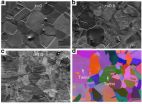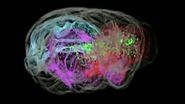(Press-News.org) Research in mice and human cell lines has identified an experimental compound dubbed TTT-3002 as potentially one of the most potent drugs available to block genetic mutations in cancer cells blamed for some forms of treatment-resistant leukemia.
Results of the research by Johns Hopkins Kimmel Cancer Center investigators, described March 6 in the journal Blood, show that two doses a day of TTT-3002 eliminated leukemia cells in a group of mice within 10 days. The treatment performed as well as or better than similar drugs in head-to-head comparisons.
More than 35 percent of acute myeloid leukemia (AML) patients harbor a mutation in the gene FMS-like tyrosine kinase-3 (FLT3). Normal FLT3 genes produce an enzyme that signals bone marrow stem cells to divide and replenish. But when FLT3 is mutated in some AML patients, the enzyme stays on permanently, causing rapid growth of leukemia cells and making the condition likely to relapse after treatment.
Many investigators are developing and testing drugs designed to block the FLT3 enzyme's proliferation, several of which are now in clinical trials. So far, their effectiveness has been limited, according to Donald Small, M.D., Ph.D., the Kyle Haydock Professor of Oncology and director of pediatric oncology at Johns Hopkins. Small led a team of researchers who originally cloned the FLT3 gene and linked it to leukemia a decade ago.
"We're very excited about TTT-3002, because it appears in our tests so far to be the most potent FLT3 inhibitor to date," says Small. "It showed activity against FLT3-mutated cells taken from patients and with minimal toxicity to normal bone marrow cells, making it a promising new candidate for the treatment of AML."
In a series of experiments with the drug, Small, postdoctoral fellow Hayley Ma, Ph.D., and others found that the amount of TTT-3002 needed to block FLT3 activity in human leukemia cell lines was six- to sevenfold lower than for the most potent inhibitor currently in clinical trials. TTT-3002 also inhibited proteins made by genes further down the FLT3 signaling pathway, including STAT5, AKT and MAPK, and showed activity against the most frequently occurring FLT3 mutations, FLT3/ITD and FLT3/D835Y. Many cancer drugs are currently ineffective against FLT3/D835Y mutations.
When the Johns Hopkins team tested the drug in a mouse model of leukemia, they found that it not only eliminated the presence of leukemic cells within 10 days of treatment but also that the mice lived an average of more than 100 days following treatment, to study completion, and resumed normal bone marrow activity. By contrast, mice treated with a placebo died an average of 18 days following treatment.
Additional studies found that TTT-3002 performed as well as sorafenib, another FLT3 inhibitor, in treating leukemic mice, and that the drug was toxic to leukemia cell samples taken from newly diagnosed and relapsed patients with AML but did not affect normal bone marrow cells taken from healthy donors.
A single dose of the medication caused more than 90 percent inhibition against FLT3 signaling that lasted for 12 hours, Small says.
INFORMATION:
Co-authors of the study were Bao Nguyen, Li Li, Sarah Greenblatt, Allen Williams, Ming Zhao, Mark Levis, Michelle Rudek and Amy Duffield.
The work was supported by the Alex's Lemonade Stand Foundation for Childhood Cancer, the National Institutes of Health's National Cancer Institute (CA90668, CA70970, CA006973, RR025005), Giant Food Pediatric Cancer Research Fund, and the Analytical Pharmacology Core of the Sidney Kimmel Comprehensive Cancer Center at Johns Hopkins.
On the Web:
Study abstract in Blood
Donald Small's biography
Related News Releases:
http://www.hopkinsmedicine.org/news/media/releases/novel_mouse_model_could_further_understanding_of_leukemias
Media Contact:
Vanessa Wasta, 410-614-2916; wasta@jhmi.edu
Amy Mone, 410-614-2915; amone@jhmi.edu
JOHNS HOPKINS MEDICINE
Johns Hopkins Medicine (JHM), headquartered in Baltimore, Maryland, is a $6.7 billion integrated global health enterprise and one of the leading health care systems in the United States. JHM unites physicians and scientists of the Johns Hopkins University School of Medicine with the organizations, health professionals and facilities of The Johns Hopkins Hospital and Health System. JHM's mission is to improve the health of the community and the world by setting the standard of excellence in medical education, research and clinical care. Diverse and inclusive, JHM educates medical students, scientists, health care professionals and the public; conducts biomedical research; and provides patient-centered medicine to prevent, diagnose and treat human illness. JHM operates six academic and community hospitals, four suburban health care and surgery centers, more than 38 primary health care outpatient sites and other businesses that care for national and international patients and activities. The Johns Hopkins Hospital, opened in 1889, was ranked number one in the nation for 21 years by U.S. News & World Report.
Experimental drug shows promise for treatment-resistant leukemias
2014-04-08
ELSE PRESS RELEASES FROM THIS DATE:
Location matters when it comes to deal-making, says new study
2014-04-08
Toronto – Even six-year-olds know who you sit beside matters, whether you're in first grade or at a high-powered dinner.
But now a new study, using the U.S. Senate Chamber as its laboratory, provides documented evidence of that phenomenon. It shows that where a person is located influences who they interact with and who they will turn to in order to build support for their own agenda.
For the powerful however, seating arrangements don't make much of a difference. That's because the people they need support from usually come to them.
The study's researchers chose ...
A new twist makes for better steel, researchers find
2014-04-08
PROVIDENCE, R.I. [Brown University] — Researchers from Brown University and universities in China have found a simple technique that can strengthen steel without sacrificing ductility. The new technique, described in Nature Communications, could produce steel that performs better in a number of structural applications.
Strength and ductility are both crucial material properties, especially in materials used in structural applications. Strength is a measure of how much force is required to cause a material to bend or deform. Ductility is a measure of how much a material ...
NASA's Aqua satellite reveals Tropical Cyclone Ita strengthening
2014-04-08
Tropical Cyclone Ita's maximum sustained winds have increased over the last day and NASA's Aqua satellite provided forecasters at the Joint Typhoon Warning Center with a visible look at the storm on April 8.
NASA's Aqua satellite passed over Ita at 3:30 UTC/11:30 p.m. EDT on April 7, and the Moderate Resolution Imaging Spectroradiometer provided a visible image of Tropical Cyclone Ita. The MODIS image showed a large area of strong thunderstorms south and northeast of the center of circulation. At the same time, the Atmospheric Infrared Sounder or AIRS instrument aboard ...
Scientists reveal potential link between brain development and breast cancer gene
2014-04-08
VIDEO:
Scientists at the Salk Institute have uncovered details into a surprising -- and crucial -- link between brain development and BCRA1, a gene whose mutation is tied to breast and ovarian cancer.
Click here for more information.
LA JOLLA—Scientists at the Salk Institute have uncovered details into a surprising—and crucial—link between brain development and a gene whose mutation is tied to breast and ovarian cancer. Aside from better understanding neurological damage associated ...
Why binge drinkers are slower to heal from their wounds
2014-04-08
MAYWOOD, Ill. – People who are injured while binge drinking are much slower to heal from wounds suffered in car accidents, shootings, fires, etc.
Now a new study is providing insights into why alcohol has such a negative effect on wound healing. Loyola University Chicago Stritch School of Medicine researchers report that binge alcohol exposure significantly reduced levels of key components of the immune system involved in healing.
The study by senior author Katherine A. Radek, PhD, and colleagues from Loyola's Alcohol Research Program and the Infectious Disease and ...
Global health funding reaches new high as funding priorities shift
2014-04-08
Washington, D.C.—Global health funding hit an all-time high of $31.3 billion in 2013, five times greater than in 1990. Yet with 3.9% growth from 2012 to 2013, the year-over-year increase falls short of the rapid rates seen over the previous decade, according to new research by the Institute for Health Metrics and Evaluation (IHME) at the University of Washington being published online in a web first edition on April 8 by Health Affairs.
As funding from many bilateral donors and development banks has declined, growth in funding from the GAVI Alliance, the Global Fund ...
UNC researchers find genetic trigger for RSV-induced infant hospitalizations
2014-04-08
April 8, 2014 CHAPEL HILL, N.C. – Researchers at UNC School of Medicine have pinpointed a viral protein that plays a major role in making respiratory syncytial virus (RSV) the most common cause of hospitalization in children under one year of age.
The discovery, published April 8 in the Journal of Clinical Investigation, is the first step toward identifying better diagnostics and potential treatments for an infection that strikes nearly all children before they reach the age of three and causing severe disease in 3 percent of infected children. RSV infection leads to ...
The double whammy of multiple sex partners and drinking in HIV/STI prevention
2014-04-08
PHILADELPHIA (April 8, 2014) – The cartoon character Homer J. Simpson once said "Alcohol: The source of, and solution to, all of life's problems."
The sage of the ubiquitous and fictional town of Springfield may have hit the nail on the head when it comes to human immunodeficiency virus (HIV) and sexually transmitted infections (STIs) counseling and prevention. The more you drink and/or the more sex partners you have, the less likely you are to engage in HIV-prevention programs.
This rather grim assessment came about from the study, "Barriers to accessing HIV-prevention ...
Language structure… you're born with it
2014-04-08
Humans are unique in their ability to acquire language. But how? A new study published in the Proceeding of the National Academy of Sciences shows that we are in fact born with the basic fundamental knowledge of language, thus shedding light on the age-old linguistic "nature vs. nurture" debate.
THE STUDY
While languages differ from each other in many ways, certain aspects appear to be shared across languages. These aspects might stem from linguistic principles that are active in all human brains. A natural question then arises: are infants born with knowledge of how ...
Advanced warning systems increase safety at intersections, study shows
2014-04-08
Most drivers have experienced a traffic signal that turns yellow just as they approach an intersection, which makes it difficult for them to decide whether to stop or proceed through it. The wrong choice in this situation, known as the "dilemma zone," may lead to crashes, especially at high-speed intersections.
A major factor making driving difficult is hazards that are sudden and hard to predict. Roadside and in-vehicle display warning systems may help drivers handle these hazards by predicting their occurrence and providing advanced warning to the driver, according ...





